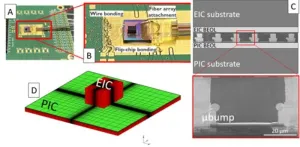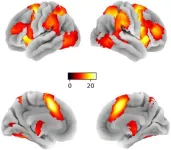(Press-News.org) Recent advancements in AI and more specifically large language models such as ChatGPT have put a strain on data centers. AI models require huge amounts of data to train, and in order to move data between the processing units and memory, efficient communication links become necessary. For long distance communication, fiber optics has already been the go-to solution for decades. For short distance intra-data center communication, the industry is now also starting to adopt fiber optics due to its great performance compared to classical electrical links. Recent technological developments now even enable the switch from electrical to optical interconnect for very small distances, such as the communication between chips inside the same package.
This requires a conversion of the data stream from the electrical to the optical domain, which happens in the optical transceiver. Silicon photonics is the most widely used technology for fabricating these optical transceivers. The active photonic devices inside the chip (modulators and photodetectors) still require a connection with electronic drivers for powering the devices and reading the incoming data. Stacking the electronic chip (EIC) right on top of the photonic chip (PIC) by means of 3D stacking technology realizes a very tight integration of the components with low parasitic capacitance.
In research recently published in the Journal of Optical Microsystems, the thermal impact of this 3D integration is investigated. The design of the photonic chip consists of an array of ring modulators, which are known for their temperature sensitivity. In order to operate in a demanding environment, such as a data center, they need active thermal stabilization. This is implemented in the form of integrated heaters. For energy efficiency reasons, it is obvious that the power required for thermal stabilization should be minimized.
The research team from KU Leuven and imec in Belgium measured the heater efficiency of the ring modulators experimentally before and after flip-chip bonding of the EIC on the PIC. A relative loss of -43.3% in efficiency was found, which is a significant impact. Furthermore, 3D finite element simulations attributed this loss to heat spreading in the EIC. This heat spreading should be avoided, because in the ideal case all heat that is generated in the integrated heater is contained close to the photonic device. The thermal crosstalk between the photonic devices also increased by up to +44.4% after bonding the EIC, which complicates the individual thermal control.
Quantifying the thermal impact of 3D photonic-electronic integration is important, but so is the prevention of heater efficiency loss. For this reason, a thermal simulation study was conducted where typical design variables were changed with the goal of increasing the heater efficiency. It is shown that by increasing the spacing between µbumps and the photonic device, and by decreasing the interconnect linewidth, the thermal penalty of 3D integration can be minimized.
Read the Gold Open Access paper by Coenen at al., “Thermal modeling of hybrid three-dimensional integrated, ring-based silicon photonic–electronic transceivers” J. Opt. Microsys. 4(1) 011004 (2023) doi: 10.1117/1.JOM.4.1.011004.
END
Thermal impact of 3D stacking photonic and electronic chips
Researchers investigate how the thermal penalty of 3D integration can be minimized
2023-12-07
ELSE PRESS RELEASES FROM THIS DATE:
Protein found in brain linked to frontotemporal dementia
2023-12-07
INDIANAPOLIS—An international team of researchers including experts at the Indiana University School of Medicine has identified a protein found in the brains of people with frontotemporal dementia (FTD), discovering a new target for potential treatments for the disease.
According to the National Institutes of Health, FTD results from damage to neurons in the frontal and temporal lobes of the brain. People with this type of dementia typically present symptoms, including unusual behaviors, emotional problems, trouble communicating, difficulty with work or in some cases difficulty with walking, ...
CU's CellSight contributes light-sensitive retinal organoids and RPE cells to new AMD study
2023-12-07
A partnership between ophthalmology researchers at the University of Colorado School of Medicine and Johns Hopkins University expands the understanding of how oxidative stress contributes to the development of choroidal neovascularization (CNV) in patients with age-related macular degeneration (AMD).
To study the roles oxidative stress, a condition in which the body lacks antioxidants, and hypoxia play in the progression of AMD, Johns Hopkins University researchers turned to CellSight, the ocular stem cell and regeneration research program in the CU Department of Ophthalmology, for tools that allow researchers to explore specific conditions ...
Novel stem cell therapy using technology from mRNA COVID-19 vaccines may stimulate natural repair in treatment of chronic and acute liver disease
2023-12-07
BOSTON – Mortality related to end stage liver disease is ranked as the 12th most common cause of death in the U.S. Liver transplantation remains the only treatment for end stage liver disease, but there is a critical shortage of organ donors, necessitating a dire need for new forms of treatment.
New research from Boston Medical Center and Boston University Chobanian & Avedisian School of Medicine’s Center for Regenerative Medicine (CReM) found evidence that a novel stem cell treatment, using mRNA technology encapsulated into nanoparticles (LNP) that was ...
Unlocking brain secrets: New insights into how our minds control impulses
2023-12-07
Published in the 2023 Volume 3 issue of Psychoradiology a team of dedicated researchers from The University of Hong Kong and The University of Electronic Science and Technology of China has conclusively identified the right inferior frontal gyrus (rIFG) as a key input and causal regulator within the subcortical response inhibition nodes. This right-lateralized inhibitory control circuit, characterized by its significant intrinsic connectivity, highlights the crucial role of the rIFG in orchestrating top-down cortical-subcortical control, underscoring the intricate dynamics of brain function in response inhibition.
In ...
How the first contact of the virus influences the immune response to new SARS-CoV-2 variants
2023-12-07
Although SARS-CoV-2 is no longer a stranger to the immune system, new virus variants still pose a challenge. The working group led by Professor Dr Florian Klein, Director of the Institute of Virology at the University Hospital Cologne and the Faculty of Medicine, has now published two studies investigating how the antibody response to SARS-CoV-2 changes over time and how the immune system is preparing itself for new variants with clever strategies. The work has been published under the title ‘Enhanced ...
Sage partners with Overton on free-to-use tool that empowers researchers to uncover their policy impact
2023-12-07
Sage has launched a tool to empower researchers to discover the real-world impact of their work on policy. Sage Policy Profiles lets researchers easily see specific citations of their work in policy documents and then illustrate and share that work’s impact graphically. The tool is powered by Overton, which hosts an extensive repository of global policy documents, guidelines, think-tank publications, and working papers.
The free-of-charge, browser-based tool shows researchers where their work appears in evidence-based policies, offering insights into how policymakers make use of their research. Sage Policy Profiles presents these results ...
New open-source platform cuts costs for running AI
2023-12-07
ITHACA, N.Y. – Cornell University researchers have released a new, open-source platform called Cascade that can run artificial intelligence models in a way that slashes expenses and energy costs while dramatically improving performance.
Cascade is designed for settings like smart traffic intersections, medical diagnostics, equipment servicing using augmented reality, digital agriculture, smart power grids and automatic product inspection during manufacturing – situations where AI models must react within a fraction of a second.
With the rise of AI, many companies are eager to leverage new capabilities but worried about the associated computing ...
NIH study suggests maternal inflammation risk factors associated with children's behavioral and emotional regulation
2023-12-07
Maternal inflammation risk factors may be associated with dysregulation in children, according to a study funded by the Environmental influences on Child Health Outcomes (ECHO) Program at the National Institutes of Health. “Dysregulation” in this context refers to children’s attention, anxiety and depression, and aggression being measurably different from what is typically expected at their age.
While inflammation is a normal bodily response to injury or infection, ECHO investigators wanted to learn whether factors linked ...
Cancer: Towards a new treatment for leukaemia
2023-12-07
Around 320,000 new cases of leukaemia, a type of blood cancer that can affect all population groups, are diagnosed every year in Europe. In children, cases of leukaemia make up a third of diagnosed cancers. Chemotherapy is the main treatment for leukaemia. Often, the exact cause cannot be identified and the molecular and cellular mechanisms responsible for leukaemia remain shrouded in mystery. Discovering new detection methods and new treatments to eradicate leukaemia is therefore a major challenge in oncology.
Messenger RNA has been in the news in recent months, in connection with COVID-19 vaccinations. In an article published in Molecular Cell, researchers ...
Wasps that recognize faces cooperate more, may be smarter
2023-12-07
ITHACA, N.Y. – A new study of paper wasps suggests social interactions may make animals smarter. The research offers behavioral evidence of an evolutionary link between the ability to recognize individuals and social cooperation.
Furthermore, genomic sequencing revealed that populations of wasps that recognized each other – and cooperated more – showed recent adaptations (positive selection) in areas of the brain associated with cognitive abilities such as learning, memory and vision.
The study focused on two distinct populations of paper wasps (Polistes fuscatus): A southern ...
LAST 30 PRESS RELEASES:
Scientists trace microplastics in fertilizer from fields to the beach
The Lancet Obstetrics, Gynecology, & Women’s Health: Taking paracetamol during pregnancy does not increase risk of autism, ADHD or intellectual disabilities, confirms new gold-standard evidence review
Taking paracetamol during pregnancy does not increase risk of autism, ADHD or intellectual disabilities
Harm reduction vending machines in New York State expand access to overdose treatment and drug test strips, UB studies confirm
University of Phoenix releases white paper on Credit for Prior Learning as a catalyst for internal mobility and retention
Canada losing track of salmon health as climate and industrial threats mount
Molecular sieve-confined Pt-FeOx catalysts achieve highly efficient reversible hydrogen cycle of methylcyclohexane-toluene
Investment in farm productivity tools key to reducing greenhouse gas
New review highlights electrochemical pathways to recover uranium from wastewater and seawater
Hidden pollutants in shale gas development raise environmental concerns, new review finds
Discarded cigarette butts transformed into high performance energy storage materials
Researchers highlight role of alternative RNA splicing in schizophrenia
NTU Singapore scientists find new way to disarm antibiotic-resistant bacteria and restore healing in chronic wounds
Research suggests nationwide racial bias in media reporting on gun violence
Revealing the cell’s nanocourier at work
Health impacts of nursing home staffing
Public views about opioid overdose and people with opioid use disorder
Age-related changes in sperm DNA may play a role in autism risk
Ambitious model fails to explain near-death experiences, experts say
Multifaceted effects of inward foreign direct investment on new venture creation
Exploring mutations that spontaneously switch on a key brain cell receptor
Two-step genome editing enables the creation of full-length humanized mouse models
Pusan National University researchers develop light-activated tissue adhesive patch for rapid, watertight neurosurgical sealing
Study finds so-called super agers tend to have at least two key genetic advantages
Brain stimulation device cleared for ADHD in the US is overall safe but ineffective
Scientists discover natural ‘brake’ that could stop harmful inflammation
Tougher solid electrolyte advances long-sought lithium metal batteries
Experts provide policy roadmap to reduce dementia risk
New 3D imaging system could address limitations of MRI, CT and ultrasound
First-in-human drug trial lowers high blood fats
[Press-News.org] Thermal impact of 3D stacking photonic and electronic chipsResearchers investigate how the thermal penalty of 3D integration can be minimized

